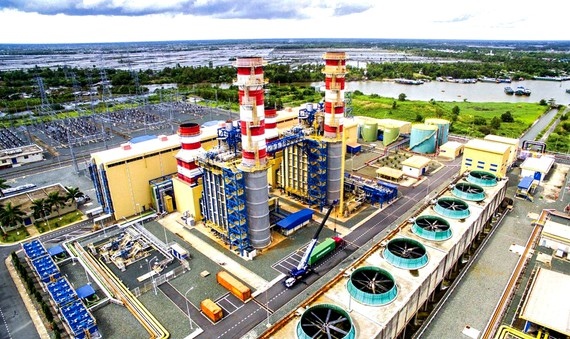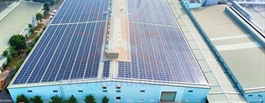LNG projects in jeopardy with rising fuel costs
LNG projects in jeopardy with rising fuel costs
The ongoing Russia-Ukraine war has caused the price of oil and gas to skyrocket, putting investors for Liquefied Natural Gas (LNG) projects in Vietnam in a serious dilemma.
Illustrative photo. |
LNG is a kind of fossil fuel that is considered the most environment friendly since it produces 30% less CO2 than oil, and 50% less CO2 than coal, and has the lowest carbon emissions. This is the reason why so many countries across the globe have turned to LNG for production of electric power.
Supply shortage
Recent studies and reports issued by the Institute for Energy Economics and Financial Analysis (IEEFA) show that LNG prices have risen from USD 8.21 per Million Metric British Thermal Unit (MMBTU) in January 2021, to USD 24.71 per MMBTU in January 2022. More recently, the Russia-Ukraine conflict has caused LNG prices to surge uncontrollably across the globe, way beyond any previous predictions. Ms. Purva Jain, an IEEFA analyst, said that LNG spot prices are predicted to go over USD 50 per MMBTU from now until September, and even USD 40 per MMBTU by the fourth quarter. Previously, experts estimated that the year 2022 would mark a watershed in LNG contracts, based on crude oil prices which are very likely to soar.
Only in the last ten-year period from 2011 to 2021, LNG prices in the world underwent wild fluctuations. From late 2011 till early 2014, LNG prices were relatively high, and LNG prices around the world at times reached an average of USD 17.24 per MMBTU. Excess supply in early 2016 caused LNG spot prices in Asia to plummet to USD 4.05 per MMBTU, but the chilly weather in late 2016 and early 2017, particularly in Europe and North America, pushed LNG spot prices up to USD 9.95 per MMBTU. LNG spot prices in 2016 averaged USD 5.52 per MMBTU in Northeastern Asia. The fierce competition in the production of gas in 2019 led to excess supply while demand fell seriously due to the effects of the Covid-19 pandemic. However, LNG prices soon increased again.
Asia accounts for three fourths of imported LNG worldwide. As the global economy is recovering, Asian countries are competing with Europe in LNG imports, mainly from the USA. China has now overtaken Japan and become the world's biggest LNG importer. Although demand has increased, LNG supply has not satisfied the actual needs. Except in the USA, which is the world's largest LNG supplier. The LNG supply now in Australia, Russia, Qatar and Norway is experiencing a sudden short-term shortage. LNG facilities in the USA as well as Australia and Qatar have launched full-scale operations, but it could take several years to expand their operations or to build new facilities.
Impact on LNG imports
It is to be seen whether high increases in LNG prices have a serious impact on plans to launch LNG powered electric plants in Vietnam. So far, not a single LNG powered electric plant has completed construction, leave aside starting operations, even though under the Revised Master Plan VII, investment plans for several LNG powered electric plants have been approved and implementation of the plans will be underway very soon.
On 14 March 2022, the investors of PV Power for the Nhon Trach LNG powered electric Project 3 and Project 4, with a capacity of 1,500MW, signed an EPC contract with Samsung C&T and Lilama to get ready for ground breaking. Nine LNG powered electric plants have had their plans approved and they will receive investment in the form of independent power plants (IPP). Five of the plans have investors and may take the next step to negotiate a power purchase agreement (PPA) with Vietnam Electricity (EVN), while other major projects like Long Son LNG, Ca Na LNG, Long An LNG and Quang Ninh LNG projects have not officially made their investors known to the public.
The Electricity Draft Plan VIII proposed by the Ministry of Industry and Trade to the Government on 21 February, is expected to be able to produce 38,830MW of LNG powered electricity with 23,900MW capacity by newly invested LNG powered electric plants and 14,930MW produced by old existing facilities that have switched to LNG due to shortage of local gas. The capacity is expected to be 56,830MW of LNG powered electricity by 2045, with 41,900MW produced by newly invested LNG powered electric plants, and 14,930MW produced by newly switched facilities.
Currently proposals for LNG powered electric facilities under the Electricity Plan VIII of the above mentioned scales are facing enormous hindrances as LNG prices have been increasing since late 2021 and early 2022, and will continue to increase because of the ongoing Russia-Ukraine conflict, which is raging on with no end in sight.
The Bac Lieu LNG powered electric plant has been invested by Delta Offshore Energy PTE.LTD (DOE) and along with other investment partners is expected to produce 3,200MW of electricity. The plant will be built in Vinh Hau A Commune of Hoa Binh District in the southern Mekong Delta province of Bac Lieu. The LNG port warehouse is located in the sea waters of Bac Lieu Province, about 35km from the electric plant. The project was first proposed for ground breaking in 2020 and was set to have its first generating station put in operation in 2024, the second generating station in operation by 2025, and the third and fourth generating stations in operation by 2026.
When fully operational, the plant is expected to produce about 9bn kWh per year. On 15 August 2019, in Document 24/BL-LNG sent to the Chairman of the People's Committee of Bac Lieu Province, along with a copy also sent to the Prime Minister and the Ministry of Industry and Trade, the investor DOE affirmed that it would sell electricity at 7 cents per kWh. However, the latest plan for this project is to break ground in the second quarter of 2022, but the investor has not been able to reach an electricity selling price with EVN.
With LNG prices soaring high at present, people may wonder at what price the plant will be able to sell electricity to EVN. If the price remains unchanged, which is 7 cents per kWh, as pledged by the investor, the plant will certainly operate at a loss. However, if the price is any higher, EVN and consumers may not accept it easily. Experts believe that the LNG fired electricity plant wishes to sell electric power at the price of 8 cents or 9 cents per kWh, provided that LNG prices stay at around USD 12 per MMBTU. However, this may not happen, at least not for the time being, because LNG powered electric plants depend totally on LNG imports.






















